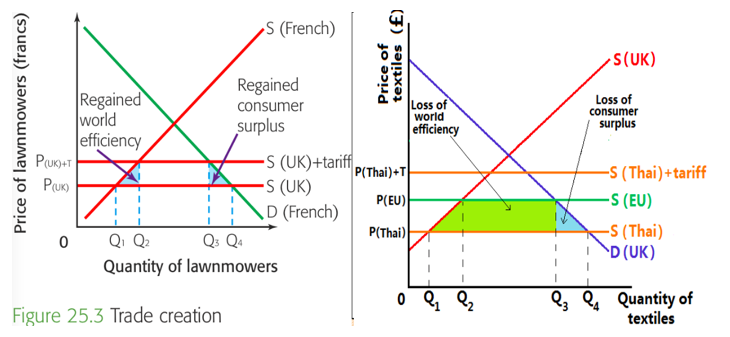Economics integration
Economic integration
It describes a process whereby countries coordinate and link their economic policies. As the degree of economic integration increases, the trade** barriers** between countries decrease and their fiscal and monetary policies are more closely harmonized.
Bilateral trade agreement
It is an agreement relating to trade between two countries. The aims are usually to reduce or remove tariffs or quotas that have been placed on the trade between these two countries.
Multilateral trade agreement
It is an agreement relating to trade between multiple countries.
Preferential trade area
It is lower but not eliminate barriers among members.
Free trade area
It eliminates internal barriers, but maintain independent external barriers
Customs union
It eliminates internal barriers, agree on common external barriers.
Common market
It eliminates internal barriers, adopt common external barriers, allow free movement of factors of production among member countries.
Economic & Monetary union
It eliminates internal barriers, adopt common external barriers, free movement of resources, and a uniform set of monetary policies.
Advantages:
- Eliminates exchange rates risk and uncertainty
- eliminates transaction cost
- encourages price transparency
- promotes higher level of inward investment.
Disadvantages:
- individual countries are no longer free to set their own interest rates and the tools of monetary policy
- Individual countries are not able to alter their own exchange rates in order to affect the international competitiveness and BOP
- The initial costs of converting the individual currencies into one currency are very large.
Full integration
For example, the united states. (both fiscal and monetary policies are the same)
Evaluation of trading bloc
Benefit:
- allows member countries to expand into larger market and gain from economy of scale
- Trade creation
- Lower prices & more choice for consumers, higher real incomes & improved life quality (cheaper imports)
- More foreign investment
- increased competition,better use of factors of production and greater economic growth and improve efficiency in production
- Greater political stability & cooperation
Cost:
- trade diversion
- Fall in employment in certain industries
- Exploitation of workers (cut labor’s wage to cut down cost to maintain competitiveness)
- Environmental effects
- Rising trade imbalances
- Discriminatory policies against non-members, damage multilateral WTO negotiations
Trade creation
It refers to the situation where higher cost products are replaced by lower cost imports after the formation of trading bloc.
- (domestic high-cost producer exits market)
- (import from foreign low-cost producer increases)
- consumers get better off
- allocation of scarce resources is more efficient
Trade diversion
It refers to the situation where lower cost imports are replaced by higher cost imports from a member after the formation of trading bloc.
- Fall in output: Q3Q4(from OQ4 to OQ3)
- Consumers worse off: - P↑: P(Thai)to P(EU) - C↓: 0Q4→0Q3
- World efficiency loss: (Q1Q2+Q2Q3) *(P(EU) – P(Thai))
- Consumers’ Surplus loss: (Q3Q4) *(P(EU) – P(Thai))
World Trade Organization (WTO)
It is an international body that sets the rules for global trading, resolves disputes between its member countries, and hosts negotiations concerning the reduction of trade barriers between its member nations.
The WTO aims to increase free trade by lowering trade barriers & providing a forum for negotiation.
- Trade without discrimination
- Free trade through negotiation
- Predictability through binding and transparency
- Promoting fair competition
- Encouraging development (≠economic growth)
functions:
- Provide a forum for trade negotiation
- Execute/administer WTO agreements
- Handle trade disputes among member countries (evaluate & rule on complaints)
- Provide technical assistance & training to developing countries on trade issues
- Track/monitor member trade policies
- Cooperate with other international organizations

